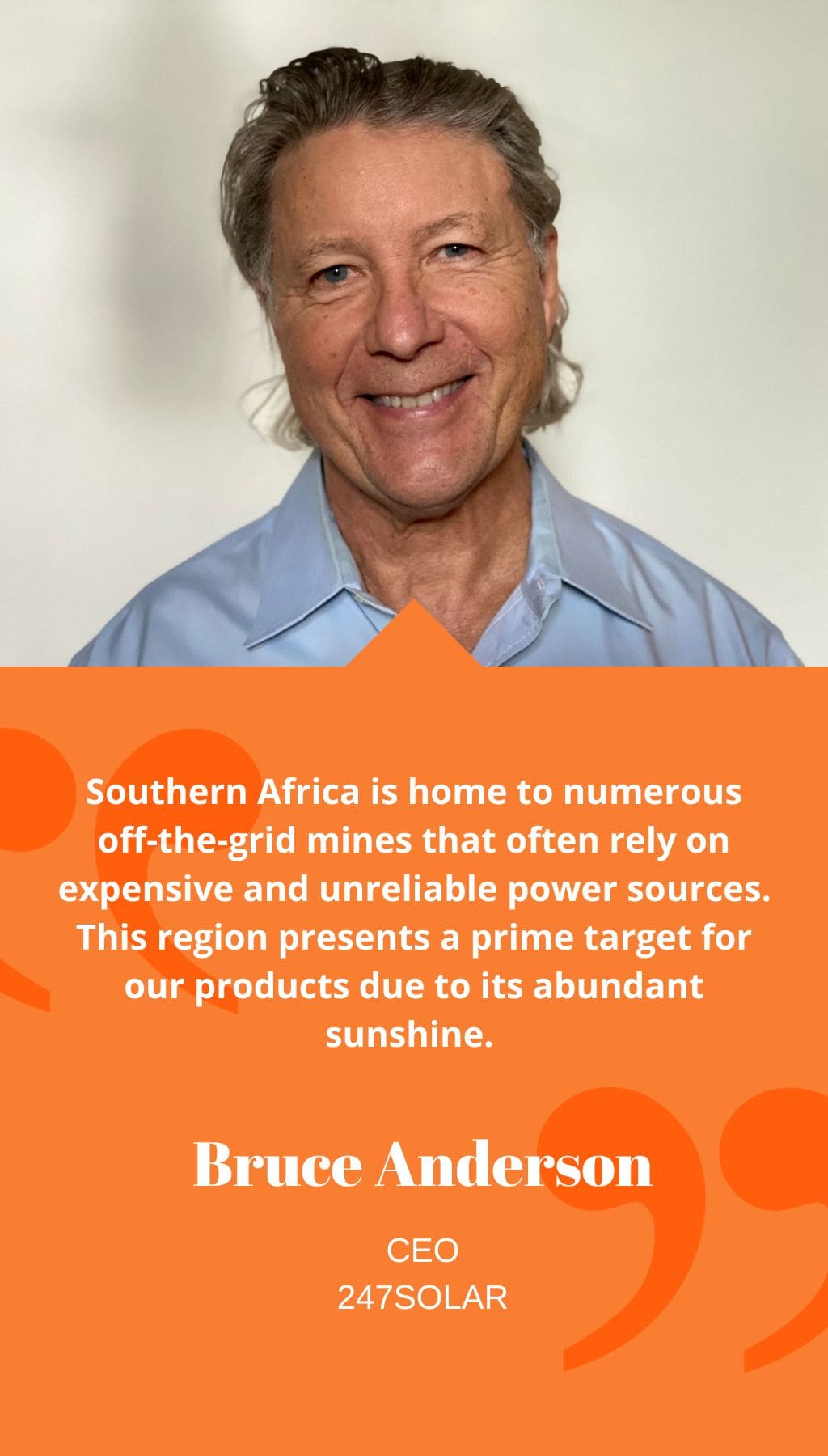
- South Africa | 19 April 2019

Can you provide an introduction to 247Solar?
Certainly. 247Solar was established in 2015 and emerged from technology developed by a spinoff from the prestigious Massachusetts Institute of Technology (MIT), with support from the US Department of Energy. After years of development, we are now entering the market with our innovative products, specifically targeting the mining industry.
We recognized that the mining sector had significant energy needs, given its energy-intensive operations and the challenges of accessing reliable and affordable power, especially for off-the-grid mines. Additionally, the industry’s strong focus on environmental, social, and governance (ESG) factors and zero-carbon initiatives caught our attention.
Currently, we are actively working on establishing redundant suppliers across the globe to ensure operational continuity, particularly in the face of unforeseen events such as the ongoing pandemic.
What are some of 247Solar’s projects in Southern Africa?
Southern Africa is home to numerous off-the-grid mines that often rely on expensive and unreliable power sources. This region presents a prime target for our products due to its abundant sunshine. We are currently engaged in discussions with mining companies in countries such as Botswana, Namibia, South Africa, Zambia, and Mozambique.
However, it is worth noting that mines in Africa are cautious when it comes to risk. Since we are in the process of executing our first 247Solar plant in Arizona, USA, mining companies in Africa generally require a reference plant to be operational before deploying commercial systems on their mine sites. Therefore, we plan to begin deploying commercial systems starting next year, once the first plant is complete and its operational data has been thoroughly analyzed.
What are some of the mining applications of the 247Solar Plant?
Unlike photovoltaic (PV) and wind systems, our 247Solar Plants operate continuously throughout the day. These plants can support a wide range of power project sizes, from 400 kWe to large central power plants with virtually unlimited capacity. The operation of our plants is based on utilizing solar heat to power the Heat2Power turbines. During daylight hours, the turbines are driven by hot air generated through the solar heating process. Additionally, some of the hot air is stored as thermal energy in our HeatStorE batteries, enabling the turbines to continue operating using stored heat even during the evenings.
Can you elaborate on the mechanism and advantages of the Heat2Power turbines?
Our Heat2Power turbines offer a compelling value proposition, with lower annual ownership costs compared to traditional generators. These turbines are unique in that they are powered directly by hot air, rather than steam. They can even burn various liquid fuels, including hydrogen. Notably, our turbines are the first commercial turbines capable of producing power directly from ambient-pressure hot air without combustion or emissions.
Since the turbines spin in a single direction, they require only 4-8 hours of routine maintenance annually, significantly reducing costs and increasing overall efficiency.
Will 247Solar be seeking partners to help distribute its products worldwide?
While we collaborate with local partners in the countries where we operate, they do not serve as our distributors. These partners may not possess the complete knowledge and capabilities for installation and servicing, as those responsibilities are undertaken by our trained personnel, with a focus on utilizing trained locals wherever possible. Maintenance and after-market activities can be easily carried out by local individuals and miners who have received training from 247Solar.
Do you foresee hydrogen playing an increasing role in the mining industry in the near future?
In the off-grid mining market, I do not believe hydrogen will become a predominant energy source anytime soon. There are various challenges associated with hydrogen, including its production costs and transport issues, which resemble those of other fuels such as diesel. Lowering the cost of producing green hydrogen and addressing transportation logistics to remote off-grid mines are significant hurdles to overcome. It is unlikely that mines will start producing their own hydrogen on-site in the near future, except for experimental purposes. However, hydrogen may be initially embraced to power vehicles on-site rather than being used as the primary energy source for mining operations.
Where do you see the highest growth potential for 247Solar?
Southern Africa presents significant growth opportunities for 247Solar in the future. We are actively pursuing customers in Sudan, where every mine operates off the grid. Political stability is a key factor that influences our assessment of various jurisdictions, as regions with higher political risks or ongoing conflicts may pose financing challenges due to the associated risks for the financial community.














